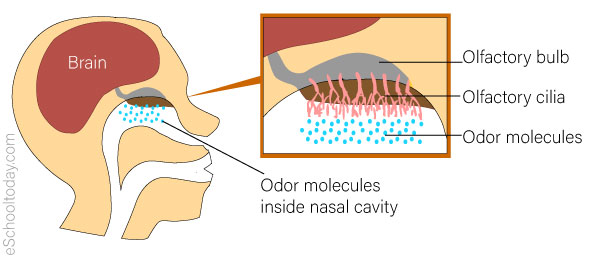- The Five Senses
The Nose and the Sense of Smell
One key factor to note about our sense of smell is that there have to be some very tiny particles (molecules) from whatever we smell. Think about cooking food or burning a candle, or spraying a perfume: all these release tiny molecules that our eyes do not see, into the air we breathe. But what happens during smelling?
The organ for smell is the nose. Here is the diagram of the entire system.

At the roof of our nasal cavity, there are tiny hairs called olfactory cilia. These hairs get stimulated after they pick up chemicals in the air going into our lungs. As they pick up the signal, they send it to the olfactory bulb. The impulse is then sent to the brain for interpretation. Note that for the brain to assign a particular smell to a signal, it uses its memory. This means, for the first time you smell something, good or bad, the brain stores it appropriately.
The sensory receptors in the nose that pick up chemicals are called Chemoreceptors. These receptors get tired after constantly receiving signals of the same stimuli. This is why if you stay in a smelly room for a long time, it becomes normal until you go out and come back in.
It is believed that over 80% of what we perceive as taste is actually due to smell. This means if food smells great, you are more likely to love the taste of it. Funny huh?
The receptors cover an area of about a small post stamp in your nose. When you have a bad cold, mucus covers that part of the nose, reducing the amount of stimulus the receptors pick. This is why you cannot smell yummy food when you catch a cold!
